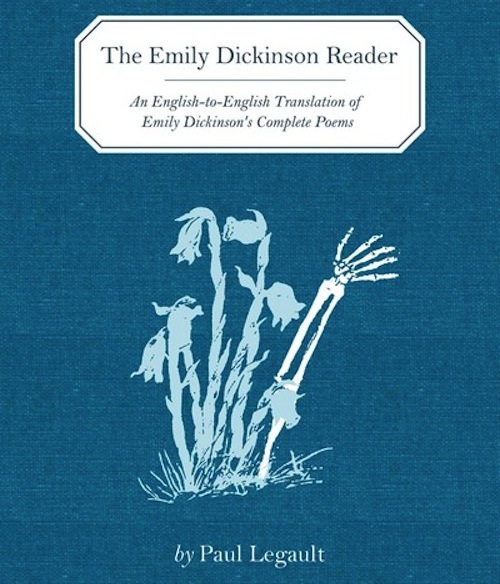'Not a Simple Joke': LARB Review of Paul Legault's Emily Dickinson Reader

At the Los Angeles Review of Books, Paul Legault's The Emily Dickinson Reader is given a proper review by Alexandra Socarides, who describes the translation project as "a joke." But a good one:
That being said, Legault's is not a simple joke, and, like all complicated jokes, it addresses much more than we recognize at first. In fact, by the time I got about 50 “translations” in, I had moved past my initial impression — that Legault was simply trying to paraphrase Dickinson’s dense and enigmatic poems in a witty, and sometimes snarky, way. He does do that some of the time, but he also understands Dickinson well enough to capitalize on her poems’ greatest strengths: their linguistic complexity, their indeterminate subjects and referents, their ability (and downright invitation) to be read “slant.” In this way, Legault couldn’t have picked a better writer to work with, and Dickinson meets him more than halfway.
Socarides also notes that the matching Dickinson's depth of thought with Legault's simpler conducting starts aesthetically, in the cover and design of the book itself:
Upon first glance it is a very stately book, printed in hardback with a royal blue cover and gold-edged paper. The title, subtitle, and author’s name appear in a font that connotes both seriousness and precision; a delicate yellow ribbon that hangs between the pages marks it as a book in which one will want to keep his or her place. Readers familiar with Dickinson’s publication history will notice that the image on the cover of Legault’s book is the same image of Indian Pipes (one of Dickinson’s favorite flowers) that adorned her very first book of poems, which was published in 1890. But upon closer inspection, Legault’s book doctors the image, inserting the arm of a skeleton that is reaching out of the grassy ground on which the Indian Pipes have long resided.
She goes on to delineate six ways of reading, including "You like Legault’s lines just as they are," "Legault sends you back to Dickinson," "You immediately recognize the connection between Legault’s line and Dickinson’s poem and you are amused by it," "You like the idea, regardless of the corresponding poem, that Dickinson might be expressing such strange and bold ideas," and these:
You recognize that some of Legault’s lines are so Dickinsonian that you wish Dickinson had written them herself.
For instance, “I tried to think of what the saddest thing in the world was so long that I became it” (570). Or, maybe even better is 695: “I cannot access what I need to survive, and I like it that way.” It is in these lines that Legault fully captures Dickinson’s strange and seemingly contradictory emotional inclinations, proving that he knows this writer inside out.
Every now and then, you feel that Legault actually writes something that, for whatever reason, Dickinson could not articulate herself.
For instance, 165: “I’m passive-aggressive. I hold my emotions in, so when they do come out, they destroy everything in their path, and they will destroy you, and you should probably run, or I will destroy you.” This is a characterization of herself that Dickinson would never have made. Instead she wrote, “I have a little shape — it would not crowd your Desk” and “I am small, like the Wren.” So when the future poet, Legault, writes such a bald characterization of Dickinson and puts it in her voice, it is powerful because it reminds us of Dickinson’s often disingenuous poses.
When I first heard of Legault’s book, I was skeptical, both of the impulse behind the project and the format. I wondered why he hadn’t included Dickinson’s poems along with his texts and I rolled my eyes at the idea that he did all 1,789 of them; the joke would surely wear thin. Even if you liked a few, why would you ever read the entire book? I emerged from my reading, however, with the realization that while this project may have started as a joke and may occasionally border on gimmick — reproducing the famous image of Dickinson several times throughout the book, each with a cheeky caption — it turns out to be a complex appropriation of this already very complicated writer. I ultimately understood that the book works better without the inclusion of Dickinson’s actual poems, which would have forced readers to approach Legault’s lines only in a one-to-one relation to the originals. To be honest, the only point at which I was frustrated with this book was when reading the “Translator’s Note,” where Legault doesn’t do justice to how interesting his project is. Here he seems unsure whether he is justifying his project (he quotes Dickinson’s editor, Franklin, on the idea that “a literary work is separable from its artifact”) or excusing the more extravagant aspects (Dickinson as zombie!) of his joke.
It should be clear by this point that I got a tremendous amount out of Legault’s “translations,” partially because they taught me about Dickinson, the nature of paraphrase, and contemporary verse, but maybe more importantly because they taught me something about reading. . . .
Read the full piece here.


